Brazil: Outlook Vulnerable To Developed Market Developments
By Win Thin
BRL, like the rest of EM, will remain hostage to developments in DM. It appears that conditions in the euro zone will likely have to get a lot worse before policy-makers are forced into more concrete actions to truly end the debt crisis there. Looking back at the 2008-2009 EM meltdown as well as the September 2011 selloff, we see that BRL was amongst the worst performers in EM. We see a similar dynamic unfolding as the euro zone crisis lurches back towards the abyss, and so we expect strong underperformance of BRL within EM going into year-end. Given our negative view on the euro zone crisis, we remain defensive on BRL and look for weakness to continue into year-end.
Retracement levels to look for from the September-October drop in USD/BRL are around 1.8135 and 1.8468, break of which targets the September high of 1.9549. Note that the minimal 38% retracement of the big 2008-2011 drop in USD/BRL came in around 1.95, and break of that would target the 50% level around 2.075. We are painting a fairly negative short-term picture for BRL and EM. However, price action over the past selloffs suggests that once the DM situation improves or stabilizes, a natural bid for EM will emerge. BRL snapped back quickly from the moves to 1.90 and 1.95 in recent months, underscoring this dynamic quite nicely.
Some recent developments in Brazil are worth a look. Local press reported this week that the authorities are considering elimination of the IOF tax on foreign equity inflows from 2% currently. No adjustment to the 6% on foreign fixed income is being discussed, but this news suggests that Brazil is worried about another blowout in BRL and could be looking at precautionary actions. Could the fixed income IOF tax be adjusted downward? It is possible, but it would likely take another huge leg up in USD/BRL to put this back on the table. As we saw back in September, Brazil intervened aggressively to stabilize USD/BRL and suggests that they do not want a weaker real at any cost. However, lack of any IOF adjustment then (despite rumors) suggests a high threshold for change.
COPOM meets November 29/30 and is widely expected to cut rates 50 bp to 11%, the third straight cut of such magnitude. The economy is clearly slowing, and so we expect easing to continue in 2012. Inflation and inflation expectations are finally turning lower, albeit modestly, giving the central bank cover to keep cutting. Those looking for a steeper pace of easing have been disappointed, however, and we think the current pace is maintained into 2012. Market sees end-2011 SELIC rate of 11% and end-2012 rate of 10% (down from 10.5% last week and reflecting recent weakness in data).
To wit, IP has contracted y/y in two of the last three months, retail sales growth has slowed to mid-single digits, and even export growth has slowed to 20% y/y in October (the slowest since mid-2010). Monthly GDP data suggest growth will slow to around 1.9% y/y in Q3 from 3.1% y/y in Q2. While this would seem to argue for more aggressive easing, IPCA inflation is still close to 7% in October and well above the 2.5-6.5% target range. Also, unemployment of 6% remains near the cycle low, and the big minimum wage hike next year will keep upward pressure on overall wages since many are indexed to changes in the minimum.
Brazil stands out now for being one of the few in EM to be cutting rates. We think most in EM will be cutting rates by Q1 2012 due to the deteriorating global growth outlook, and so BRL will still likely continue to enjoy a big yield advantage over other EM currencies next year. The current account and budget deficits remain very manageable, with inflows of FDI more than covering the former. There are many reasons to remain constructive on BRL, but the DM story unfolding suggests that we are months away from clear sailing for EM.
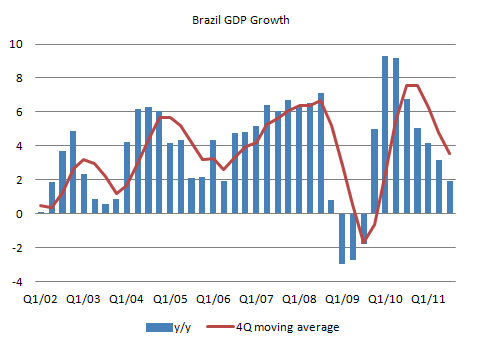
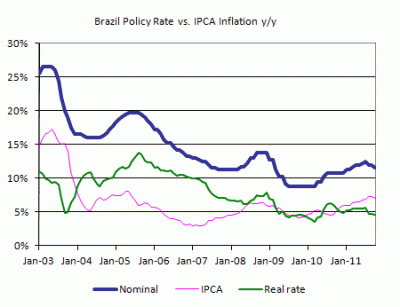
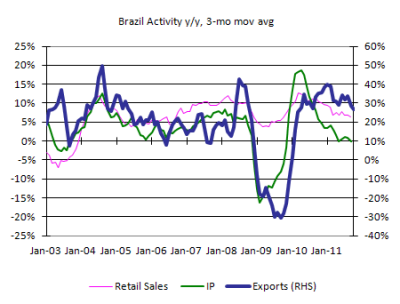
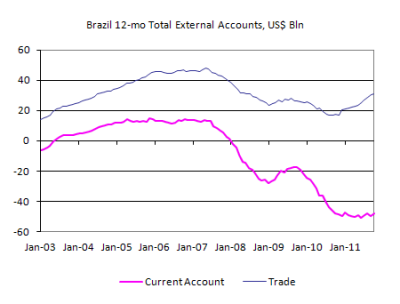
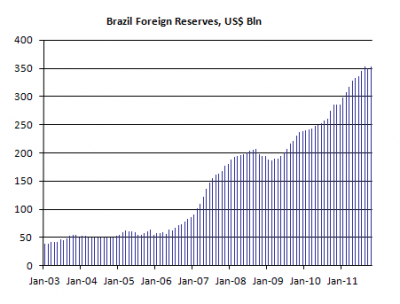
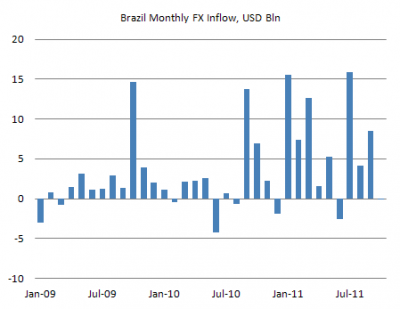
Comments are closed.